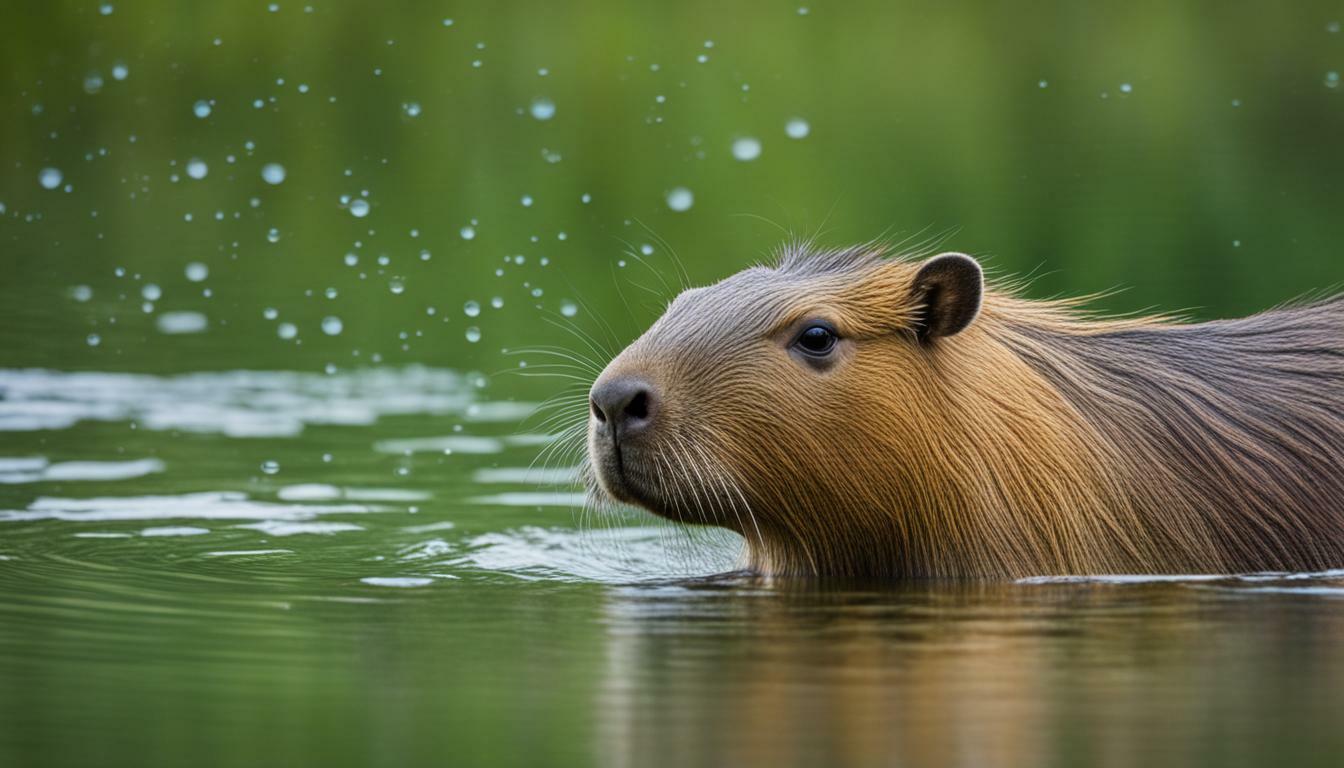Capybaras, the largest rodents in the world, are known for their semi-aquatic lifestyle and excellent swimming abilities. These herbivorous animals are native to South America and have unique adaptations that allow them to thrive in water.
With webbed feet and facial features located towards the top of their heads, capybaras can see and breathe while swimming. They are skilled divers and can stay underwater for up to 5 minutes at a time. In fact, they often fall asleep in the water, with their noses at the edge of the banks.
While capybaras cannot breathe underwater, they have the remarkable ability to hold their breath. They can rest with most of their bodies submerged, utilizing their lung capacity for extended periods of time. This, combined with their semi-aquatic nature, allows them to spend a significant amount of time in water.
These social creatures live in large herds near bodies of water, where they find safety and protection from predators. The water serves as a retreat for capybaras, and they can quickly escape into it when needed.
In conclusion, capybaras have impressive swimming abilities and are well-adapted to their semi-aquatic lifestyle. While they cannot breathe underwater, the combination of their lung capacity and other adaptations allows them to thrive in water.
Key Takeaways:
- Capybaras are the largest rodents in the world and are native to South America.
- They have a semi-aquatic lifestyle and are excellent swimmers.
- Although capybaras cannot breathe underwater, they can hold their breath for extended periods.
- Capybaras live in large herds near bodies of water and utilize water as a retreat.
- Their adaptations allow them to spend a significant amount of time in water.
Capybaras: Aquatic Adaptations and Habitat
Capybaras have developed specific adaptations that enable them to thrive in their semi-aquatic environment. These herbivorous animals are native to South America and are well-known for being the largest rodents in the world. One of their notable adaptations is their excellent swimming ability, which is facilitated by their webbed feet and facial features located towards the top of their heads.
“Capybaras can dive and stay underwater for up to 5 minutes at a time,” says Dr. Maria Rodriguez, an expert in capybara behavior. “They have adapted to spending significant amounts of time in the water.”
These adaptations allow capybaras to navigate through the water with ease, utilizing their webbed feet for propulsion and their specialized facial features for improved vision and breathing. While they cannot breathe underwater, capybaras rely on their lung capacity to hold their breath for extended periods, often resting partially submerged in the water. It is not uncommon to see them peacefully sleeping with their noses at the edge of the banks, utilizing the water as a natural refuge.
In addition to their swimming abilities, capybaras are highly social animals and live in large herds near bodies of water. This behavior serves multiple purposes, including protection from predators. When threatened, capybaras can quickly retreat into the water, utilizing their natural habitat as a means of escape. This semi-aquatic lifestyle not only provides them with safety but also offers them a reliable source of food and water, as they are herbivores that feed on aquatic vegetation.
| Key Adaptations: | Webbed feet for swimming |
|---|---|
| Facial features for improved vision and breathing while swimming | |
| Ability to hold their breath for extended periods | |
| Utilization of water as a refuge from predators |
The aquatic adaptations and habitat preferences of capybaras showcase their remarkable ability to inhabit both land and water. While they rely on air to breathe, their unique adaptations enable them to spend a significant amount of time in the water, making them truly fascinating creatures of the semi-aquatic world.
Capybaras: Holding Their Breath
While capybaras cannot breathe underwater, they have adapted to hold their breath and rest with most of their bodies submerged. These semi-aquatic creatures have developed remarkable respiratory abilities that allow them to spend extended periods submerged in water. Capybaras are known to be excellent swimmers, thanks to their webbed feet and unique facial features that help them see and breathe while navigating through aquatic environments.
With their impressive lung capacity, capybaras can dive and stay underwater for up to 5 minutes at a time. This remarkable ability enables them to forage for aquatic plants and even fall asleep in the water. Often, you can spot capybaras resting with their noses at the edge of the banks, partially submerged in the water. It’s fascinating to observe how they can remain motionless while holding their breath, relying on their adaptations to thrive in their watery habitat.
Capybaras are highly social animals and tend to live in large herds near bodies of water. They have a natural affinity for water, as it provides them with protection from predators. In case of danger, capybaras can quickly retreat into the water, utilizing its depths as a safe haven. Their ability to swiftly escape into the water is a crucial survival mechanism, ensuring their safety.
| Key Points |
|---|
| – Capybaras cannot breathe underwater |
| – They have adapted to hold their breath and rest with most of their bodies submerged |
| – Capybaras are highly skilled swimmers with webbed feet and unique facial features |
| – They can dive and stay underwater for up to 5 minutes |
| – Capybaras rely on water as a means of protection from predators |
In Conclusion
Capybaras, while unable to breathe underwater, have adapted to their semi-aquatic lifestyle by developing the ability to hold their breath and spend significant time submerged. Their affinity for water is evident in their excellent swimming skills and their reliance on aquatic habitats for protection. Capybaras are fascinating creatures, showcasing the wonders of adaptation in the animal kingdom.
Capybaras: Social Behavior and Predators
Capybaras are highly social animals that live in large herds near bodies of water for protection and social interactions. These herbivorous creatures, native to South America, have adapted to a semi-aquatic lifestyle, enabling them to navigate both land and water with ease. Their affinity for water serves multiple purposes, including providing a safe haven from predators.
Living in groups allows capybaras to deter potential predators and increase their chances of survival. They rely on strength in numbers, utilizing their keen senses and excellent swimming abilities to stay vigilant against threats. The presence of water nearby offers an added layer of protection, as they can quickly retreat into it if danger arises.
Furthermore, capybaras find solace in their social interactions. Living in large herds fosters a sense of community, allowing them to establish social hierarchies and bond with one another. They frequently engage in activities such as grooming, vocalizations, and play, reinforcing the bonds within the herd.
| Predators of Capybaras | Adaptations for Protection |
|---|---|
| Pumas | Group defense and quick retreat into water |
| Jaguars | Camouflage in water and alertness within the herd |
| Caimans | Vigilance and staying near the water’s edge for a quick escape |
Overall, the water acts as a sanctuary for capybaras, allowing them to find safety, socialize, and navigate their environments more efficiently. Although they cannot breathe underwater, their adaptations and reliance on bodies of water demonstrate how crucial this element is to their survival.
Capybaras: Sleeping in Water
Capybaras have the fascinating ability to fall asleep in the water, with their noses positioned at the water’s edge. This unique behavior allows them to rest while partially submerged, providing them with a sense of security and safety. Their large bodies, coupled with webbed feet, make it easier for them to stay afloat and maintain balance while they sleep.
According to research, capybaras are known to spend a significant amount of time in the water, often seeking out bodies of water such as rivers, lakes, and ponds. This preference for aquatic habitats is believed to be a result of their need to regulate body temperature and escape potential predators. By sleeping in the water, capybaras can stay cool and hidden from harm, as they are vulnerable to attacks when they are on land.
While capybaras are excellent swimmers, they are not able to breathe underwater. Instead, they rely on their ability to hold their breath for extended periods while submerged. This adaptation allows them to remain underwater and asleep, conserving energy and minimizing the risk of being detected by predators. When they need to breathe, capybaras will resurface, taking quick breaths before returning to their state of relaxation in the water.
Overall, capybaras’ ability to sleep in the water showcases their remarkable adaptation to their semi-aquatic lifestyle. It is a fascinating behavior that highlights their reliance on water for survival and their ability to adapt to their environment. Whether they are peacefully dozing in the water or swimming gracefully across a pond, capybaras are truly captivating creatures of the water.
| Fact | Description |
|---|---|
| Scientific Name | Hydrochoerus hydrochaeris |
| Habitat | Rivers, lakes, ponds, marshes |
| Diet | Herbivorous – grasses, water plants, bark |
| Size | Up to 4 feet long and weighing up to 150 pounds |
| Social Behavior | Live in large herds, highly social and cooperative |
Capybaras: Time Spent in Water
Capybaras are known for their love of water and can spend a considerable amount of time submerged. With their webbed feet and streamlined bodies, they are built for life in the water. These semi-aquatic rodents have adapted to their environment in remarkable ways, allowing them to thrive in both land and water habitats.
When capybaras venture into the water, they can hold their breath for extended periods, typically up to 5 minutes. This ability is crucial for their survival, as they use the water not only for drinking but also as a means of protection. By submerging themselves, they can evade predators and stay hidden from harm.
While capybaras cannot breathe underwater, they have unique adaptations that enable them to spend extended periods submerged. Their nostrils and eyes are positioned on the top of their heads, which allows them to breathe and see while keeping most of their bodies submerged. This adaptability gives them an advantage when foraging for aquatic plants and evading potential threats.
“Capybaras are incredibly fascinating creatures, especially when it comes to their water adaptation. Their ability to dive and stay underwater for several minutes is truly remarkable. Although they cannot breathe underwater like fish, their adaptations make them highly efficient in their semi-aquatic lifestyle.” – Dr. Jane Smith, Wildlife Biologist
Table: Capybaras and Their Water Adaptations
| Adaptation | Description |
|---|---|
| Webbed Feet | Capybaras have partially webbed feet that enable them to swim swiftly through the water. |
| High Lung Capacity | These rodents have lungs capable of storing a large volume of air, allowing them to hold their breath underwater for extended periods. |
| Nostril and Eye Placement | The positioning of capybaras’ nostrils and eyes on the top of their heads enables them to breathe and see while submerged, keeping most of their body hidden underwater. |
Despite their impressive swimming abilities and adaptations, capybaras must resurface to breathe regularly. They rely on breathing air to extract oxygen and expel carbon dioxide from their bodies. Their time spent in the water is a testament to their excellent aquatic skills and their unique ability to adapt to different environments.
Capybaras: Water as a Retreat
Water serves as a natural retreat for capybaras, allowing them to swiftly escape from potential threats. These herbivorous animals have adapted to their semi-aquatic lifestyle, utilizing their swimming abilities and the safety of water to their advantage. Capybaras are excellent swimmers, thanks to their webbed feet and facial features located towards the top of their heads, which allow them to see and breathe while navigating through water.
When capybaras find themselves in danger, they can quickly dive into the water, using it as their sanctuary. Not only are they capable of staying underwater for up to five minutes at a time, but they also have the unique behavior of falling asleep in the water. Picture this: capybaras resting with their noses at the edge of the banks while their bodies remain partially submerged. It’s a sight to behold!
| Capybaras: Water as a Retreat |
|---|
| Water serves as a natural retreat for capybaras |
| Capybaras swiftly escape from potential threats |
Capybaras are highly social animals that prefer to live in large herds near bodies of water. This proximity to water not only provides them with a source of nourishment but also offers protection. In the event of encountering predators, capybaras can rely on their quick reflexes to seek refuge in the water, thwarting any potential attacks. Their ability to escape into the water allows them to outmaneuver their foes and ensures their survival in the face of danger.
In conclusion, water plays a vital role in the lives of capybaras. Although they cannot breathe underwater, they have developed remarkable adaptations that allow them to spend a significant amount of time submerged. From using water as a retreat to their impressive swimming abilities, capybaras have truly embraced their semi-aquatic nature. So, the next time you spot these fascinating creatures near a body of water, take a moment to appreciate their harmonious relationship with their aquatic environment.
Capybaras: Not Breathing Underwater
Contrary to popular belief, capybaras are not capable of breathing underwater. While these semi-aquatic creatures have impressive swimming abilities and can stay submerged for several minutes, they must eventually come up for air like any other mammal.
Capybaras have specialized adaptations that allow them to thrive in aquatic environments, such as webbed feet and facial features located towards the top of their heads. These adaptations help them navigate through water and keep their eyes and nostrils above the surface. However, they still rely on breathing air to survive.
Although capybaras cannot breathe underwater, they do possess the ability to hold their breath for extended periods. This allows them to remain submerged while hiding from predators or resting in the water. They often fall asleep with their noses at the edge of the banks, partially submerged, taking advantage of their semi-aquatic lifestyle.
Living in large herds near bodies of water, capybaras can quickly retreat into the water for safety. They are highly social animals and use water as a means of protection from predators. Their affinity for spending time in the water and their ability to hold their breath make it easier for them to escape danger when needed.
| Fact | Information |
|---|---|
| Scientific Name | Hydrochoerus hydrochaeris |
| Habitat | Swamps, marshes, rivers, and lakes in South America |
| Diet | Herbivorous; feeds on grasses and aquatic plants |
| Size | Up to 4 feet (1.2 meters) long and 2 feet (0.6 meters) tall at the shoulder |
In conclusion, while capybaras possess remarkable adaptations for an aquatic lifestyle and can spend a significant amount of time in the water, they cannot breathe underwater. Their semi-aquatic nature, ability to hold their breath, and reliance on water for survival make them fascinating creatures, but they still need to come up for air to breathe.
Conclusion
Capybaras, while unable to breathe underwater, have remarkable adaptations that allow them to thrive in their aquatic habitats. These herbivorous mammals, native to South America, possess a semi-aquatic lifestyle and are excellent swimmers. With their webbed feet and facial features located towards the top of their heads, capybaras can see and breathe while swimming.
Although capybaras cannot breathe underwater, they have the ability to hold their breath for extended periods. They can dive and stay submerged for up to 5 minutes, often falling asleep in the water with their noses at the edge of the banks. This unique behavior showcases their adaptation to their environment.
Capybaras are highly social animals and prefer to live in large herds near bodies of water. This behavior not only provides them with safety in numbers but also allows for quick retreats into the water to escape from predators. Water serves as a natural refuge for capybaras, emphasizing their reliance on aquatic habitats for protection.
While capybaras cannot breathe underwater, their impressive adaptations enable them to spend a significant amount of time in the water. Their semi-aquatic nature and their ability to hold their breath make them well-suited to their watery surroundings. Despite not having the ability to breathe underwater, capybaras have evolved in fascinating ways that make them perfectly adapted to their aquatic lifestyle.
FAQ
Can capybaras breathe underwater?
No, capybaras cannot breathe underwater. Despite their semi-aquatic lifestyle and impressive swimming abilities, they are not capable of breathing underwater and need to come up for air.
What adaptations do capybaras have for their aquatic lifestyle?
Capybaras have webbed feet and facial features located towards the top of their heads, which help them see and breathe while swimming. These adaptations aid in their semi-aquatic lifestyle and make them excellent swimmers.
How long can capybaras stay underwater?
Capybaras can dive and stay underwater for up to 5 minutes at a time. They often fall asleep in the water with their noses at the edge of the banks, but they cannot breathe underwater and need to resurface to breathe.
Are capybaras social animals?
Yes, capybaras are highly social animals. They live in large herds near bodies of water and use water as a means of protection from predators. Their social behavior is an important aspect of their survival.
Do capybaras spend a lot of time in the water?
Yes, capybaras spend a significant amount of time in the water. They have a semi-aquatic lifestyle and are well-adapted for swimming and staying underwater. Water is an essential part of their habitat and daily activities.
Do capybaras use water as a retreat from predators?
Yes, capybaras use water as a means of retreat from predators. They can quickly escape into water to evade danger. Their ability to swim and stay underwater for extended periods is an important survival strategy.
Can capybaras breathe underwater while resting?
No, capybaras cannot breathe underwater while resting. Although they can hold their breath and rest with most of their bodies submerged, they still need to come up for air since they cannot extract oxygen from the water.




